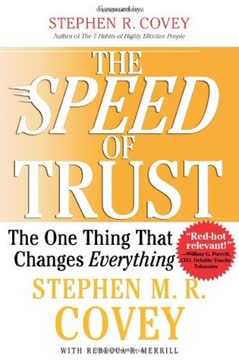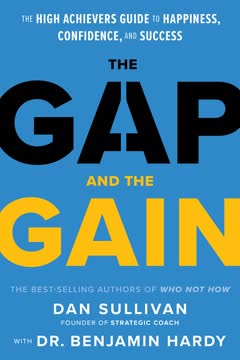Key Takeaways
1. Wealth is Freedom, Not a Number
Wealth is freedom.
Freedom from worry. True wealth isn't about a specific dollar amount; it's about the freedom from financial anxiety and the ability to live a meaningful life. It's the peace of mind that comes from knowing your financial future is secure, allowing you to focus on what truly matters.
- Wealth is not a destination, but a state of being.
- It's about having enough, not having more.
- It's about living life on your own terms.
Income from investments. Wealth is achieved when your investments generate enough income to support your desired lifestyle, independent of your labor. This allows you to pursue passions, spend time with loved ones, and contribute to society without financial constraints.
- It's about having an income you can't outlive.
- It's about having the ability to leave a legacy.
- It's about having the freedom to choose.
Beyond accumulation. Wealth is not just about accumulating assets; it's about the positive freedom to live a life that is meaningful to you. It's about having the resources to pursue your passions, support your loved ones, and make a difference in the world. It's about the ability to give back and create a lasting impact.
2. Be an Owner, Not a Loaner
The Megatruth is: real wealth comes to, and abides with, the owners of great companies, not the lenders to great companies.
Equity vs. Debt. The fundamental difference between stocks (equity) and bonds (debt) is that stocks represent ownership in a business, while bonds represent loans to a business. Owners participate in the profits and growth of the business, while lenders receive a fixed rate of return.
- Owners take more risk, but also have the potential for much higher returns.
- Lenders take less risk, but also have limited upside potential.
- In the long run, owners have historically outperformed lenders.
Historical returns. Over the long term, stocks have significantly outperformed bonds, both before and after accounting for inflation and taxes. This is because owners of businesses capture the value created by those businesses, while lenders only receive a fixed interest payment.
- From 1926-1998, stocks returned 11.2% annually, while bonds returned 5.5%.
- After inflation, stocks returned 8.1%, while bonds returned 2.4%.
- After inflation and taxes, stocks returned 5.8%, while bonds returned 0.8%.
Homeownership analogy. The concept of owner vs. loaner is similar to buying a home with a mortgage. The homeowner captures the appreciation in the value of the home, while the lender only receives the principal and interest payments. The homeowner takes on more risk, but also has the potential for much greater reward.
3. Volatility is Not Risk
Risk is not knowing what you're doing.
Misunderstanding risk. Most investors equate volatility (price fluctuations) with risk, but this is a fundamental misunderstanding. Volatility is a normal part of the stock market, while true risk is the permanent loss of capital.
- Volatility is temporary; loss is permanent.
- Stocks are more volatile than bonds, but they also have higher long-term returns.
- The key is to focus on long-term growth, not short-term fluctuations.
Time heals all. The risk of owning stocks decreases over time. Historically, the longer you hold stocks, the less likely you are to lose money. This is because the market tends to recover from downturns and continue its long-term upward trend.
- No 15-year period since 1926 has shown a negative return for the S&P 500.
- The market always recovers from bear markets.
- Time is the investor's greatest ally.
Fear is the enemy. The biggest obstacle to investment success is fear, which often leads investors to sell low during market downturns. This turns temporary volatility into permanent losses. The key is to remain calm, disciplined, and focused on the long-term.
- Fear is a greater influence than historical evidence.
- The ability to distinguish between volatility and loss is critical.
- No panic, no sell. No sell, no lose.
4. The Real Risk is Not Owning Equities
The real long-term risk of equities is not owning them.
Erosion of purchasing power. The greatest long-term financial risk is not losing your money, but outliving it. Inflation erodes the purchasing power of your savings over time, and bonds and CDs typically do not provide returns that keep pace with inflation.
- Inflation has averaged 3.1% per year since 1926.
- At 3.1% inflation, prices will triple in 30 years.
- Bonds and CDs have historically provided little to no real return after inflation and taxes.
Stocks as inflation hedge. Stocks, on the other hand, have historically provided returns that significantly outpace inflation, preserving and growing your purchasing power over time. This makes them essential for long-term wealth building and retirement planning.
- Stocks have historically returned 7% annually after inflation.
- Dividends from stocks tend to increase over time, keeping pace with inflation.
- Stocks are the only asset class that has consistently provided real returns.
Retirement planning. A fixed-income investment strategy is a recipe for disaster in a rising-cost world. Retirees need an income stream that grows over time to keep pace with inflation, and only stocks can provide that.
- Bonds and CDs are not safe for long-term retirement planning.
- Stocks are essential for generating an income you can't outlive.
- The real risk is not losing your money, but outliving it.
5. Behavior Trumps Performance
Wealth isn't primarily determined by investment performance, but by investor behavior.
Control what you can. The single most important variable in your investment success is your own behavior, which is the only thing you can ultimately control. Trying to time the market or pick the best-performing funds is a futile exercise.
- Focus on what you can control, not what you can't.
- Your behavior is the key to your financial success.
- Don't let emotions drive your investment decisions.
Long-term plan. Successful investing requires a long-term plan, discipline, and patience. It's about consistently investing in equities, regardless of market conditions, and avoiding the temptation to chase short-term gains or panic during downturns.
- Set specific, measurable, achievable, relevant, and time-bound (SMART) goals.
- Create a plan for achieving those goals.
- Stick to your plan, even when it's difficult.
Dollar-cost averaging. Investing the same dollar amount at regular intervals (dollar-cost averaging) is a powerful tool for building wealth over time. It allows you to buy more shares when prices are low and fewer shares when prices are high, resulting in a lower average cost per share.
- Dollar-cost averaging removes the need to time the market.
- It makes you a disciplined buyer, even during market downturns.
- It's a simple, yet effective, way to build wealth over time.
6. Diversify Across Equity Sectors
To every thing there is a season, and a time to every purpose under heaven.
No single panacea. No single investment strategy or sector will always outperform the others. Different sectors and styles of investing go through cycles of outperformance and underperformance.
- The S&P 500 is not a panacea.
- Small-cap stocks, foreign stocks, and growth stocks all have their seasons.
- Diversification is key to capturing long-term returns.
Five-part portfolio. A well-diversified equity portfolio should include exposure to different sectors and styles, such as large-cap growth, small-cap growth, large-cap value, small-cap value, and international stocks. This helps to reduce overall portfolio volatility and capture the long-term returns of different market segments.
- Growth and value stocks tend to move counter-cyclically.
- Small-cap stocks have higher long-term returns, but also higher volatility.
- International stocks provide diversification and exposure to global growth.
Avoid over-diversification. While diversification is important, it's also possible to over-diversify, which can lead to lower returns and higher costs. A portfolio of five to nine well-chosen funds is usually sufficient for most investors.
- Don't become a collector of funds.
- Over-diversification can lead to inefficiency and higher costs.
- Focus on quality, not quantity.
7. Time in the Market, Not Timing the Market
Time in the market, as opposed to timing the market, is not a way of capturing the long-term returns of equities; it is the only practicable way.
Market timing is impossible. No one can consistently predict market tops and bottoms. Trying to time the market is a futile exercise that often leads to lower returns.
- Market timing is a fool's errand.
- No one can consistently call market tops and bottoms.
- Trying to time the market is a recipe for disaster.
Long-term perspective. The key to successful investing is to focus on the long term and avoid the temptation to make short-term decisions based on market fluctuations. The longer you stay invested, the more likely you are to capture the long-term returns of the stock market.
- Time is the investor's greatest ally.
- The market always recovers from downturns.
- Stay invested, even when it's difficult.
Buy and hold. The best strategy for long-term wealth building is to buy and hold a diversified portfolio of equities, regardless of market conditions. This allows you to capture the long-term growth of the stock market and avoid the pitfalls of market timing.
- Buy when you have the money.
- Sell when you need the money.
- Otherwise, just let them grow.
8. Find a Trusted Financial Advisor
The value of a high-quality financial advisor is a multiple of what he costs. That’s all that matters.
More than fund selection. A good financial advisor does more than just pick funds; they help you create a comprehensive financial plan, guide you through market ups and downs, and provide emotional support during difficult times.
- Fund selection is the smallest part of what a good advisor does.
- A good advisor helps you create a comprehensive financial plan.
- They guide you past fads and fears.
Behavioral coach. A key role of a financial advisor is to act as a behavioral coach, helping you to stay disciplined and avoid making emotional decisions that can derail your long-term investment plan.
- The highest function of an advisor is to convince you not to sell.
- They help you stay on track, even when it's difficult.
- They provide emotional support during market downturns.
Trust and empathy. The most important qualities in a financial advisor are trust, empathy, and a shared sense of mission. You need to feel comfortable talking to your advisor about your financial goals and concerns.
- Do not care what they know until you know that they care.
- Find an advisor who listens to you and cares about you.
- The advisor-advisee relationship is critical to success.
Last updated:
FAQ
What's "Simple Wealth, Inevitable Wealth" about?
- Author's Experience: The book is written by Nick Murray, who has over three decades of experience advising individual investors and financial advisors.
- Investment Philosophy: It focuses on the principles and practices that Murray believes are essential for achieving wealth through investing, particularly in equities.
- Core Beliefs: Murray emphasizes the importance of owning stocks over bonds for long-term wealth creation, arguing that stocks are the only financial asset with real returns after inflation and taxes.
- Behavioral Focus: The book stresses that investor behavior, rather than investment performance, is the key determinant of financial success.
Why should I read "Simple Wealth, Inevitable Wealth"?
- Practical Advice: The book offers practical, experience-based advice on how to achieve and maintain wealth through disciplined investing.
- Behavioral Insights: It provides insights into the psychological aspects of investing, helping readers understand and manage their emotions.
- Long-term Focus: Murray advocates for a long-term investment strategy, which is crucial for building sustainable wealth.
- Counter-Cultural Views: The book challenges conventional wisdom, particularly the idea that bonds are safer than stocks for retirees.
What are the key takeaways of "Simple Wealth, Inevitable Wealth"?
- Equities Over Bonds: Stocks are the best long-term investment for wealth creation, offering higher real returns than bonds.
- Investor Behavior: Successful investing is more about maintaining discipline and managing emotions than picking the right stocks or funds.
- Long-term Perspective: Time in the market is more important than timing the market; patience and discipline are crucial.
- Financial Advisor Value: A good financial advisor can provide invaluable guidance and emotional support, often worth more than their cost.
What are the best quotes from "Simple Wealth, Inevitable Wealth" and what do they mean?
- "Wealth is freedom." This quote encapsulates the book's definition of wealth as the freedom from financial worry and the ability to live a meaningful life.
- "Fear has a greater grasp on human action than does the impressive weight of historical evidence." This highlights the book's focus on the psychological barriers to successful investing.
- "Optimism is the only realism." Murray emphasizes the importance of maintaining a positive outlook on the future as a fundamental investment principle.
- "No panic, no sell. No sell, no lose." This underscores the importance of staying invested and not succumbing to fear during market downturns.
How does Nick Murray define wealth in "Simple Wealth, Inevitable Wealth"?
- Freedom from Worry: Wealth is defined as freedom from financial worry about one's future and that of one's children.
- Positive Freedom: It is the ability to live a meaningful life without the need to work for income, relying instead on investments.
- Legacy Building: Wealth includes the ability to leave a financial legacy for loved ones, ensuring their freedom as well.
- Simplicity in Process: Achieving wealth is simple but requires discipline, patience, and faith in the principles outlined in the book.
What is Nick Murray's investment philosophy in "Simple Wealth, Inevitable Wealth"?
- Equities as Core: Stocks are the primary vehicle for achieving real wealth, as they offer superior long-term returns.
- Behavior Over Performance: The focus is on investor behavior rather than trying to outperform the market or pick the best stocks.
- Long-term Commitment: A long-term perspective is essential, with an emphasis on staying invested through market cycles.
- Advisor's Role: A trusted financial advisor can help maintain discipline and provide guidance, enhancing the likelihood of success.
What does Nick Murray say about risk in "Simple Wealth, Inevitable Wealth"?
- Misunderstood Risk: People often overestimate the risk of owning stocks and underestimate the risk of not owning them.
- Volatility vs. Risk: Volatility is not the same as risk; temporary declines in stock prices are not permanent losses.
- Inflation Risk: The real risk is outliving your money, which is more likely with bonds due to inflation eroding purchasing power.
- Equities' Safety: Over the long term, equities are safer than bonds because they preserve and enhance purchasing power.
How does "Simple Wealth, Inevitable Wealth" suggest managing emotions in investing?
- Fear Management: Recognize that fear is a natural emotion but should not dictate investment decisions.
- Advisor Support: A financial advisor can provide emotional support and help prevent panic-driven decisions.
- Long-term Focus: Keeping a long-term perspective helps mitigate the emotional impact of short-term market fluctuations.
- Behavioral Discipline: Consistent, disciplined behavior is key to overcoming emotional impulses and achieving investment success.
What role does a financial advisor play according to "Simple Wealth, Inevitable Wealth"?
- Guidance and Support: Advisors provide guidance on investment strategies and emotional support during market downturns.
- Behavioral Coach: They help clients maintain discipline and avoid common investment pitfalls driven by emotions.
- Value Over Cost: The value of a good advisor often exceeds their cost, as they can enhance returns and prevent costly mistakes.
- Comprehensive Planning: Advisors assist with comprehensive financial planning, ensuring investments align with long-term goals.
What is the significance of "dollar-cost averaging" in "Simple Wealth, Inevitable Wealth"?
- Consistent Investment: Dollar-cost averaging involves investing a fixed amount regularly, regardless of market conditions.
- Market Timing Elimination: It removes the need to time the market, as more shares are bought when prices are low and fewer when prices are high.
- Volatility Advantage: This strategy takes advantage of market volatility, potentially lowering the average cost per share.
- Long-term Benefits: Over time, dollar-cost averaging can lead to significant wealth accumulation, aligning with the book's long-term focus.
How does "Simple Wealth, Inevitable Wealth" address retirement planning?
- Equity Focus: The book advocates for maintaining a significant portion of retirement portfolios in equities for growth.
- Systematic Withdrawal: It suggests a systematic withdrawal strategy, taking a fixed percentage annually to ensure income and capital growth.
- Inflation Protection: Equities provide a hedge against inflation, crucial for maintaining purchasing power in retirement.
- Legacy Consideration: The approach ensures not only a sustainable retirement income but also a financial legacy for heirs.
What are the common misconceptions about investing addressed in "Simple Wealth, Inevitable Wealth"?
- Bonds as Safe: The book challenges the notion that bonds are safer than stocks, especially for long-term investors.
- Performance Chasing: It warns against chasing recent high-performing funds, as past performance is not indicative of future results.
- Market Timing: Murray argues that timing the market is futile and that staying invested is the key to success.
- Complexity Over Simplicity: The book emphasizes that wealth-building is simple but requires discipline and adherence to fundamental principles.
Review Summary
Simple Wealth, Inevitable Wealth emphasizes a straightforward approach to investing, focusing on behavioral discipline and long-term equity ownership. Readers appreciate its clear explanations and optimistic outlook, though some find it repetitive. The book advocates for working with a financial advisor, using dollar-cost averaging, and maintaining a diversified portfolio of mutual funds. While the writing style receives mixed reviews, most agree the core principles are sound. Many readers found it helpful as an introduction to investing, particularly in understanding the importance of investor behavior.
Similar Books










Download PDF
Download EPUB
.epub digital book format is ideal for reading ebooks on phones, tablets, and e-readers.




